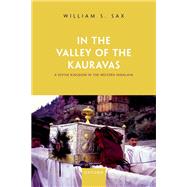In the Valley of the Kauravas A Divine Kingdom in the Western Himalaya
, by Sax, William S.- ISBN: 9780198879350 | 0198879350
- Cover: Hardcover
- Copyright: 5/1/2024
The isolated valleys of Rawain in the Western Himalaya are ruled by local gods who control the weather, provide justice, and regularly travel through their territories to mark their borders and to ward off incursions by rival gods. These, identified with Karna and Duryodhana from the great Indian epic Mahabharata, are regarded as divine kings whom local persons serve as priests, ministers, patrons, soldiers, and servants. Each divine king has an oracle, who is regularly summoned, enters into a trance, and speaks with the god's voice, appointing and dismissing officers, confiscating property, levying fines, and ratifying the decisions of councils of elders. The gods hear civil and sometimes criminal cases and, through their oracles, enforce their judgments through fines and penalties, or by compelling disputants to reach a compromise.
In the Valley of the Kauravas seeks to describe how this system functions by closely examining the myths, legends, rituals, and folklore associated with it, and above all by providing a detailed ethnographic description of its day-to-day workings. It contextualizes this system by comparing it with 'divine kingship' throughout history, in both South and Southeast Asia, and seeks to embed this historical and ethnographic analysis in a theoretical discussion of the nature, goals, and limits of anthropological knowledge of 'multiple worlds'.
The chapters of the book are organized in terms of the 'seven limbs' of the classical Indian kingdom as described by the political philosopher Kautilya: king, land and people, minister, army, treasury, ally, and enemy.
In the Valley of the Kauravas seeks to describe how this system functions by closely examining the myths, legends, rituals, and folklore associated with it, and above all by providing a detailed ethnographic description of its day-to-day workings. It contextualizes this system by comparing it with 'divine kingship' throughout history, in both South and Southeast Asia, and seeks to embed this historical and ethnographic analysis in a theoretical discussion of the nature, goals, and limits of anthropological knowledge of 'multiple worlds'.
The chapters of the book are organized in terms of the 'seven limbs' of the classical Indian kingdom as described by the political philosopher Kautilya: king, land and people, minister, army, treasury, ally, and enemy.






